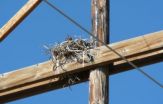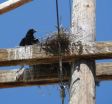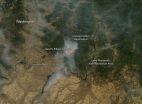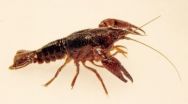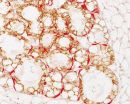(Press-News.org) A new study by the Wildlife Conservation Society (WCS), U.S. Geological Survey (USGS) and Idaho State University (ISU) explored how habitat alterations, including the addition of energy transmission towers, affect avian predators nesting in sagebrush landscapes.
Researchers compared nesting habitat selection between Common Ravens and three raptor species commonly found in sagebrush ecosystems: Red-tailed Hawks, Swainson's Hawks, and Ferruginous Hawks.
Using the data from their field research and reviewing historical data from other studies, the scientists developed models to predict nesting probabilities for each species. Overall, the analysis showed that transmission towers and other artificial substrates (e.g. cell towers, billboards, buildings) are overwhelmingly preferred by ravens as nesting sites, and are not preferred by any of the three hawk species. A nest located on artificial substrate is nearly 100 percent, 89.4 percent, and 87.1 percent more likely to be that of a raven than that of a Swainson's Hawk, Red-tailed Hawk, and Ferruginous Hawk, respectively.
"Raven populations have increased precipitously in the past four decades in sagebrush ecosystems, largely as a result of fragmentation and development of anthropogenic structures. Our study shows that in addition to habitat fragmentation, the addition of human-made structures benefit ravens, whereas some species of raptors like the Ferruginous Hawk have been impacted and limited in nesting areas," said study lead author Peter Coates, an ecologist with the USGS Western Ecological Research Center.
Why the difference in nest selection between ravens and large hawks? The answer may be linked to the availability of preferred prey. "Ravens are opportunistic foragers, eating just about anything, including carrion. In addition, they tend to be highly intelligent birds that adapt quickly to changing environments and have been shown to transmit learned behaviors from one generation to the next. Conversely, hawks tend to be strongly territorial, intolerant of human disturbance, and prefer prey like jackrabbits that occupy similar habitats," said coauthor and USGS ecologist Kristy Howe, whose masters thesis research with WCS formed the foundation of this study.
The study took place on the sagebrush landscapes of the U.S. Department of Energy's Idaho site and surrounding areas in Idaho, USA, locating nest sites for all four species over a three year span. Researchers analyzed four primary factors that influence nest locations among species:
presence of artificial nesting substrate versus natural nesting substrate (e.g. trees, cliffs, rock-outcrops)
presence/absence of agricultural fields,
amount of native grassland, and
proximity to habitat edge (where any of four natural habitat types might abut one another) and proximity to human-made features.
Ravens were classified as an uncommon breeder within this area as recently as 1986. Common Ravens are now the most pervasive predatory species nesting in this area, accounting for 46 percent of nests among these four avian predator species.
Transmission towers are the tallest objects at the study area. Nesting on or near them may afford ravens myriad advantages, including a wider range of vision, greater attack speed, and greater security from predators, range fires, and heat stress. While this is good news for ravens, it could be bad news for sensitive prey species, including the Greater Sage-Grouse.
Howe speculates on the study's other implications and directions for future research: "Since ravens are important predators of young birds and eggs, and hawks are predominantly predators of adults, these landscape changes could shift ecosystem dynamics. Predation risk would now likely be greater for sage-grouse eggs and young, and correspondingly lower for adult sage-grouse and other prey species. This adds new insights for ecosystem managers who seek to understand the complex relationships between ravens, hawks, sage-grouse populations, and habitat changes."
"Increases in Common Raven distribution and abundance in the American west mirror declines in distribution and abundance of Greater Sage-Grouse, where energy transmission corridors and other land use changes have altered sagebrush steppe habitat", said David Delehanty of ISU.
"Industrial development, wildfires, invasive plant species, and other disturbances are changing sagebrush landscapes throughout the western United States. Our results shed light on how these avian predators might change with them," said Coates of USGS.
INFORMATION:
The study, "Landscape alterations influence differential habitat use of nesting Buteos and ravens within sagebrush ecosystem: Implications for transmission line development," will appear in the August 2014 print issue of the journal The Condor.(This study is currently online.) Authors include Kristy Howe of WCS and USGS, Peter Coates and Michael L. Casazza of the USGS, and David Delehanty of ISU.
For additional information on this story, or to speak with the scientists involved, please contact Scott Smith at 718-220-3698.
Additional Study Results
Ravens:
73 percent of ravens nests were located on artificial nesting substrates, of which, 53 percent were located on transmission line towers.
Both ravens and Red-tailed Hawks selected nest sites in close proximity to habitat edges, while Swainson's and Ferruginous Hawks selected nest sites far from habitat edges.
Red-tailed Hawks:
70 percent of nests located on natural substrates (cottonwood and juniper tress)
Breeding pairs of Red-tailed Hawks, also considered a generalist species, increased substantially from the mid-1970s (1 nest) to the mid-1990s (33 nests) and have remained stable since that time.
Swainson's Hawks:
98 percent of nests located on natural substrates (juniper, cottonwood and cultivated trees)
Nested in communities dominated by native grasses and near agricultural areas
Ferrugionous Hawks:
Approximately 74 percent of nests were located on natural substrates, mostly juniper trees.
Selected areas dominated by contiguous stands of sagebrush.
Ferruginous Hawk nests were located farther from roads and other human developments when compared to the other species.
Most likely to be negatively impacted by human encroachment.
New study: Ravens rule Idaho's artificial roosts
Human-structures in sagebrush landscapes favor Common Raven nesting over historical hawk species
2014-08-11
ELSE PRESS RELEASES FROM THIS DATE:
Can fiction stories make us more empathetic?
2014-08-11
Empathy is important for navigating complex social situations, and is considered a highly desirable trait. Raymond Mar, a psychologist at York University in Canada, discussed how exposure to narrative fiction may improve our ability to understand what other people are thinking or feeling in his session at the American Psychological Association's 122nd Annual Convention.
Exposure to stories
Many stories are about people--their mental states, their relationships—even stories with inanimate objects, may have human-like characteristics. Mar explains that we understand stories ...
Julio embarking on weakening trend
2014-08-11
The Central Pacific Hurricane Center has issued its 30th warning on Julio today at 1500 GMT. Julio's position at this point is 395 miles northeast of Honolulu, Hawaii moving northwest at 8 knots per hour. Julio is moving toward the northwest near 9 mph, 15 km/h. Maximum sustained winds are near 75 mph, 120 km/h, with higher gusts. Julio is expected to weaken slightly over the next 48 hours, down to tropical storm strength by tonight.
At present, hurricane force winds extend outward up to 25 miles, 35 km, from the center, and tropical storm force winds extend outward ...
Genevieve Downgraded to a tropical storm
2014-08-11
Once Super Typhoon Genevieve has now been downgraded to a tropical storm. The storm is located approximately 819 nautical miles west-northwest of Midway Island. It is currently tracking northwestward at 8 knots per hour over the past six hours. Maximum significant wave height is 32 feet. Maximum sustained winds 70 knots gusting to 85 knots, with winds of 34 knots or higher occur within 80 to 105 miles of the cente,r and winds of 64 knots or higher occur within 15 miles of the center. No landmasses are currently threatened by this storm.
Genevieve is moving northwest ...
Southfork and Staley Complex fires in Oregon
2014-08-11
The Southfork Complex fire began with a lightning strike on July 31, 2014. The complex of Murderers Creek South fire and the Buck Fork fire is located 20 miles southwest of John Day, Oregon and has affected 62,476 acres to date. The fire area experienced a shift in direction of the prevailing winds Sunday. There were short up-slope, up-canyon runs. At present there are 798 personnel fighting this fire complex.
Projected outlook for this fire complex in the next twelve hours sees continued fire spread to to the north toward Dayville, Oregon as well as continued fire ...
Devil's Elbow Complex in Washington state
2014-08-11
The Devil's Elbow Complex is four wildfires that are located on the Colville Indian Reservation in northeastern Washington. They were detected on August 3, but were likely ignited by lightning that passed through the area on August 2.
Three fires are in the San Poil River Valley, approximately 10-12 miles north of the town of Keller, WA. These are the Cub Creek Fire (165), the Central Peak Fire (160), and the Deadhorse Fire (164). They are burning timber, grass, brush, litter, and heavy slash that resulted from a local wind storm two years ago. The terrain is very steep ...
Synthetic molecule makes cancer self-destruct
2014-08-11
Researchers from The University of Texas at Austin and five other institutions have created a molecule that can cause cancer cells to self-destruct by ferrying sodium and chloride ions into the cancer cells.
These synthetic ion transporters, described this week in the journal Nature Chemistry, confirm a two-decades-old hypothesis that could point the way to new anticancer drugs while also benefitting patients with cystic fibrosis.
Synthetic ion transporters have been created before, but this is the first time researchers have shown them working in a real biological ...
NIST therapy for ultraviolet laser beams: Hydrogen-treated fibers
2014-08-11
To make a better optical fiber for transmitting laser beams, the first idea that comes to mind is probably not a nice long hydrogen bath.
And yet, scientists have known for years that hydrogen can alter the performance of optical fibers, which are often used to transmit or even generate laser light in optical devices. Researchers at the National Institute of Standards and Technology (NIST) have put this hydrogen "cure" to practical use, making optical fibers that transmit stable, high-power ultraviolet laser light for hundreds of hours. NIST scientists expect these hydrogen-treated ...
Stanford researchers uncover cancer-causing mechanism behind powerful human oncogene
2014-08-11
A protein present at high levels in more than half of all human cancers drives cell growth by blocking the expression of just a handful of genes involved in DNA packaging and cell death, according to a new study by researchers at the Stanford University School of Medicine.
The researchers found that the protein, called Myc, works through a tiny regulatory molecule called a microRNA to suppress the genes' expression. It marks the first time that a subset of Myc-controlled genes has been identified as critical players in the protein's cancer-causing function, and suggests ...
Blood cells are a new and unexpected source of neurons in crayfish
2014-08-11
Researchers have strived for years to determine how neurons are produced and integrated into the brain throughout adult life. In an intriguing twist, scientists reporting in the August 11 issue of the Cell Press journal Developmental Cell provide evidence that adult-born neurons are derived from a special type of circulating blood cell produced by the immune system. The findings—which were made in crayfish—suggest that the immune system may contribute to the development of the unknown role of certain brain diseases in the development of brain and other tissues.
In many ...
How breast cancer usurps the powers of mammary stem cells
2014-08-11
During pregnancy, certain hormones trigger specialized mammary stem cells to create milk-producing cells essential to lactation. Scientists at the University of California, San Diego School of Medicine and Moores Cancer Center have found that mammary stem cells associated with the pregnant mammary gland are related to stem cells found in breast cancer.
Writing in the August 11, 2014 issue of Developmental Cell, David A. Cheresh, PhD, Distinguished Professor of Pathology and vice-chair for research and development, Jay Desgrosellier, PhD, assistant professor of pathology ...
LAST 30 PRESS RELEASES:
Statins significantly reduce mortality risk for adults with diabetes, regardless of cardiovascular risk
Brain immune cells may drive more damage in females than males with Alzheimer’s
Evidence-based recommendations empower clinicians to manage epilepsy in pregnancy
Fungus turns bark beetles’ defenses against them
There are new antivirals being tested for herpesviruses. Scientists now know how they work
CDI scientist, colleagues author review of global burden of fungus Candida auris
How does stroke influence speech comprehension?
B cells transiently unlock their plasticity, risking lymphoma development
Advanced AI dodel predicts spoken language outcomes in deaf children after cochlear implants
Multimodal imaging-based cerebral blood flow prediction model development in simulated microgravity
Accelerated streaming subgraph matching framework is faster, more robust, and scalable
Gestational diabetes rose every year in the US since 2016
OHSU researchers find breast cancer drug boosts leukemia treatment
Fear and medical misinformation regarding risk of progression or recurrence among patients with breast cancer
Glucagonlike peptide-1 receptor agonists and asthma risk in adolescents with obesity
Reviving dormant immunity: Millimeter waves reprogram the immunosuppressive microenvironment to potentiate immunotherapy without obvious side effects
Safety decision-making for autonomous vehicles integrating passenger physiological states by fNIRS
Fires could emit more air pollution than previously estimated
A new way to map how cells choose their fate
Numbers in our sights affect how we perceive space
SIMJ announces global collaborative book project in commemoration of its 75th anniversary
Air pollution exposure and birth weight
Obstructive sleep apnea risk and mental health conditions among older adults
How talking slows eye movements behind the wheel
The Ceramic Society of Japan’s Oxoate Ceramics Research Association launches new international book project
Heart-brain connection: international study reveals the role of the vagus nerve in keeping the heart young
Researchers identify Rb1 as a predictive biomarker for a new therapeutic strategy in some breast cancers
Survey reveals ethical gaps slowing AI adoption in pediatric surgery
Stimulant ADHD medications work differently than thought
AI overestimates how smart people are, according to HSE economists
[Press-News.org] New study: Ravens rule Idaho's artificial roostsHuman-structures in sagebrush landscapes favor Common Raven nesting over historical hawk species
